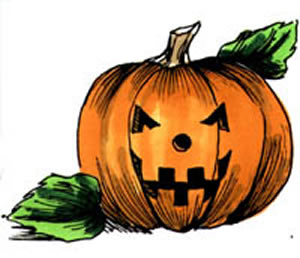What is a Halloween Party?
 Halloween is a holiday celebrated on the night of October 31, usually by children dressing in costumes and going door-to-door collecting candy. It is celebrated in much of the Western world, though most commonly in the United States, Ireland, Scotland and Canada. Irish, Scots and other immigrants brought older versions of the tradition to North America in the 19th century.
Halloween is a holiday celebrated on the night of October 31, usually by children dressing in costumes and going door-to-door collecting candy. It is celebrated in much of the Western world, though most commonly in the United States, Ireland, Scotland and Canada. Irish, Scots and other immigrants brought older versions of the tradition to North America in the 19th century.
Halloween is an annual celebration, but just what is it actually a celebration of? And how did this peculiar custom originate? Is it, as some claim, a kind of demon worship? Or is it just a harmless vestige of some ancient pagan ritual?
The word itself, “Halloween,” actually has its origins in the Catholic Church. It comes from a contracted corruption of All Hallows Eve. November 1, “All Hollows Day” (or “All Saints Day”), is a Catholic day of observance in honor of saints. But, in the 5th century BC, in Celtic Ireland, summer officially ended on October 31. The holiday was called Samhain (sow-en), the Celtic New year.
 One story says that, on that day, the disembodied spirits of all those who had died throughout the preceding year would come back in search of living bodies to possess for the next year. It was believed to be their only hope for the afterlife. The Celts believed all laws of space and time were suspended during this time, allowing the spirit world to intermingle with the living.
One story says that, on that day, the disembodied spirits of all those who had died throughout the preceding year would come back in search of living bodies to possess for the next year. It was believed to be their only hope for the afterlife. The Celts believed all laws of space and time were suspended during this time, allowing the spirit world to intermingle with the living.
Naturally, the still-living did not want to be possessed. So on the night of October 31, villagers would extinguish the fires in their homes, to make them cold and undesirable. They would then dress up in all manner of ghoulish costumes and noisily paraded around the neighborhood, being as destructive as possible in order to frighten away spirits looking for bodies to possess.
Probably a better explanation of why the Celts extinguished their fires was not to discourage spirit possession, but so that all the Celtic tribes could relight their fires from a common source, the Druidic fire that was kept burning in the Middle of Ireland, at Usinach.
Some accounts tell of how the Celts would burn someone at the stake who was thought to have already been possessed, as sort of a lesson to the spirits. Other accounts of Celtic history debunk these stories as myth.
The Romans adopted the Celtic practices as their own. But in the first century AD, Samhain was assimilated into celebrations of some of the other Roman traditions that took place in October, such as their day to honor Pomona, the Roman goddess of fruit and trees. The symbol of Pomona is the apple, which might explain the origin of our modern tradition of bobbing for apples on Halloween.
The thrust of the practices also changed over time to become more ritualized. As belief in spirit possession waned, the practice of dressing up like hobgoblins, ghosts, and witches took on a more ceremonial role.
The custom of Halloween was brought to America in the 1840’s by Irish immigrants fleeing their country’s potato famine. At that time, the favorite pranks in New England included tipping over outhouses and unhinging fence gates.
The custom of trick-or-treating is thought to have originated not with the Irish Celts, but with a ninth-century European custom called souling. On November 2, All Souls Day, early Christians would walk from village to village begging for “soul cakes,” made out of square pieces of bread with currants. The more soul cakes the beggars would receive, the more prayers they would promise to say on behalf of the dead relatives of the donors. At the time, it was believed that the dead remained in limbo for a time after death, and that prayer, even by strangers, could expedite a soul’s passage to heaven.
The Jack-o-lantern custom probably comes from Irish folklore. As the tale is told, a man named Jack, who was notorious as a drunkard and trickster, tricked Satan into climbing a tree. Jack then carved an image of a cross in the tree’s trunk, trapping the devil up the tree. Jack made a deal with the devil that, if he would never tempt him again, he would promise to let him down the tree.
According to the folk tale, after Jack died, he was denied entrance to Heaven because of his evil ways, but he was also denied access to Hell because he had tricked the devil. Instead, the devil gave him a single ember to light his way through the frigid darkness. The ember was placed inside a hollowed-out turnip to keep it glowing longer.
The Irish used turnips as their “Jack’s lanterns” originally. But when the immigrants came to America, they found that pumpkins were far more plentiful than turnips. So the Jack-O-Lantern in America was a hollowed-out pumpkin, lit with an ember.
So, although some cults may have adopted Halloween as their favorite “holiday,” the day itself did not grow out of evil practices. It grew out of the rituals of Celts celebrating a new year, and out of Medieval prayer rituals of Europeans. And today, even many churches have Halloween parties or pumpkin carving events for the kids. After all, the day itself is only as evil as one cares to make it.
Halloween, or Hallowe’en, is a holiday celebrated on the night of October 31. Traditional activities include trick-or-treating, Halloween festivals, costume parties, bonfires, visiting “haunted houses”, viewing horror films, and participating in traditional autumn activities such as hayrides (which may have “haunted” themes).
Halloween originated under the name of Samhain as a Pagan festival among the Celts of Ireland and Great Britain. Irish and Scottish immigrants carried versions of the tradition to North America in the nineteenth century. Other western countries embraced the holiday in the late twentieth century.
Halloween is now celebrated in parts of the western world, most commonly in Ireland, the United States, Canada, Puerto Rico, the United Kingdom and sometimes in Australia and New Zealand. In recent years, the holiday has also been celebrated in various other parts of Western Europe.
The term Halloween (and its older rendering Hallowe’en) is shortened from All-hallow-even, as it is the evening of/before “All Hallows’ Day”, also known as “All Saints’ Day”. It was a day of religious festivities in various northern European Pagan traditions, until Popes Gregory III and Gregory IV moved the old Christian feast of All Saints’ Day from May 13 to November 1. In the ninth century, the Church measured the day as starting at sunset, in accordance with the Florentine calendar. Although All Saints’ (or Hallows’) Day is now considered to occur one day after Halloween, the two holidays were, at that time, celebrated on the same day. Liturgically, the Church traditionally celebrated that day as the Vigil of All Saints, and, until 1970, a day of fasting as well. Like other vigils, it was celebrated on the previous day if it fell on a Sunday, although secular celebrations of the holiday remained on the 31st. The Vigil was suppressed in 1955, but was later restored in the post-Vatican II calendar.
In Ireland, the name of the holiday was All Hallows’ Eve (often shortened to Hallow Eve), and though seldom used today, the name is still well-accepted, albeit somewhat esoteric. In Irish, the festival is known as OÃche Shamhna (Night of Samhain), or simply Samhain; in Scottish Gaelic it is Samhainn or Samhain; in Welsh, Calan Gaeaf to the Welsh; “Allantide” to the Cornish and “Hop-tu-Naa” to the Manx. Halloween is also called Pooky Night in parts of Ireland, presumably named after the púca, a mischievous spirit.
Many European cultural traditions hold that Halloween is one of the liminal times of the year when spirits can make contact with the physical world, and when magic is most potent (according to, for example, Catalan mythology about witches and Irish tales of the SÃdhe).
Halloween did not become a holiday in the United States until the 19th century, where lingering Puritan tradition restricted even the observance Christmas prior to the 1800s. American almanacs of the late 18th and early 19th centuries do not include Halloween in their lists of holidays. The transatlantic migration of nearly two million Irish following the Irish Potato Famine (1845–1849) finally brought the holiday to the United States. Scottish emigration from the British Isles, primarily to Canada before 1870 and to the United States thereafter, brought the Scottish version of the holiday to each country.
Scottish-American and Irish-American societies held dinners and balls that celebrated their heritages, with perhaps a recitation of Robert Burns’ poem “Halloween” or a telling of Irish legends, much as Columbus Day celebrations were more about Italian-American heritage than Columbus per se. Home parties would center around children’s activities, such as bobbing for apples, and various divination games often concerning future romance. Not surprisingly, pranks and mischief were common as well.
The commercialization of Halloween in the United States did not start until the 20th century, beginning perhaps with Halloween postcards (featuring hundreds of designs) which were most popular between 1905 and 1915. Dennison Manufacturing Company, which published its first Hallowe’en catalog in 1909, and the Beistle Company were pioneers in commercially made Halloween decorations, particularly die-cut paper items. German manufacturers specialised in Halloween figurines that were exported to the United States in the period between the two world wars.
There is little primary documentation of masking or costuming on Halloween in the United States or elsewhere, prior to 1900. Mass-produced Halloween costumes did not appear in stores until the 1930s, and trick-or-treating did not become a fixture of the holiday until the 1950s.
In the United States, Halloween has become the sixth most profitable holiday (after Christmas, Mother’s Day, Valentines Day, Easter, and Father’s Day). In the 1990s, many manufacturers began producing a larger variety of Halloween yard decorations; prior to this a majority of decorations were homemade. Some of the most popular yard decorations are jack-o’-lanterns, scarecrows, witches, orange and purple string lights, inflatable decorations (such as spiders, pumpkins, mummies and vampires), and animatronic window and door decorations. Other popular decorations are foam tombstones and gargoyles. Halloween is now the United States’ second most popular holiday (after Christmas) for decorating; the sale of candy and costumes are also extremely common during the holiday, which is marketed to children and adults alike. According to the National Retail Federation, the most popular Halloween costume themes for adults are, in order: witch, pirate, vampire, cat and clown. On many college campuses, Halloween is a major celebration, with the Friday and Saturday nearest October 31 hosting many costume parties.
Universal’s Halloween Horror Nights is one of the largest and most elaborate Halloween events in the world. The month-long event takes place at Universal Studios theme parks in Florida and Hollywood.





I added your blog to my favorites! I love what you write about!
2xwjv411rjsvo3co